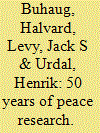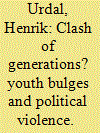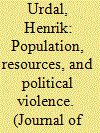|
|
|
Sort Order |
|
|
|
Items / Page
|
|
|
|
|
|
|
| Srl | Item |
| 1 |
ID:
128862


|
|
|
|
|
| Publication |
2014.
|
| Summary/Abstract |
Established in 1964, the Journal of Peace Research (JPR) celebrates 50 years. This anniversary special issue of the journal offers broad reviews of research areas that have been central both to the journal and to the field of peace and conflict research generally. An opening article co-authored by long-time editor Nils Petter Gleditsch offers a historical view on peace research and tracks trends in the use of 'peace' and 'violence' in titles of JPR across the first 49 volumes of the journal. Opening the review article section, two contributions address key thematic areas for the journal. Few if any subjects have attracted more attention in the study of international relations during the second half of JPR's first 50 years than the democratic peace, and in the extension of this subject, the broader debate about the liberal peace. Additional articles review the status and propose future developments in the study of war and its relationship with territory, ethnicity, ideology and natural resources. Another key historical topic associated with the journal concerns the economic cost of military conflict, while more recent research fields covered include terrorism and human rights, topics that have grown to become major JPR niches. Reflecting the methodological contributions by JPR, two articles focus on challenges of contemporary quantitative political analysis and progress in peace and conflict data collection. Finally, this special issue includes a review of research on international mediation in armed conflicts.
|
|
|
|
|
|
|
|
|
|
|
|
|
|
|
|
| 2 |
ID:
073550


|
|
|
|
|
| Publication |
2006.
|
| Summary/Abstract |
It has frequently been suggested that exceptionally large youth cohorts, the so-called "youth bulges," make countries more susceptible to political violence. Within two prominent theoretical frameworks in the study of civil war, youth bulges are argued to potentially increase both opportunities and motives for political violence. This claim is empirically tested in a time-series cross-national statistical model for internal armed conflict for the period 1950-2000, and for event data for terrorism and rioting for the years 1984-1995. The expectation that youth bulges should increase the risk of political violence receives robust support for all three forms of violence. The results are consistent both with an expectation that youth bulges provide greater opportunities for violence through the abundant supply of youths with low opportunity costs, and with an expectation that stronger motives for violence may arise as youth bulges are more likely to experience institutional crowding, in particular unemployment. Some contextual factors have been suggested to potentially enhance the effect of youth bulges. In an empirical test of these propositions, the study suggests that youth bulges are particularly associated with an increasing risk of internal armed conflict in starkly autocratic regimes, but a similar effect is also found for highly democratic countries. The interaction of youth bulges with economic decline and expansion in higher education appear to increase the risk of terrorism but not of rioting. Recent studies in economic demography find that when fertility is sharply decreasing, causing lower dependency ratios, large youth cohorts entering the labor market may lead to economic boosts. This study finds some empirical evidence complementing these results, indicating that the effect of youth bulges on political violence may decline along with reduced dependency ratios.
|
|
|
|
|
|
|
|
|
|
|
|
|
|
|
|
| 3 |
ID:
065120


|
|
|
|
|
| Publication |
Jul-Aug 2005.
|
|
|
|
|
|
|
|
|
|
|
|
|
|
|
|
| 4 |
ID:
082937


|
|
|
|
|
| Publication |
2008.
|
| Summary/Abstract |
Recent cross-national studies have found only moderate support for the idea that population pressure and resource scarcity may lead to political violence, contrary to much of the case study literature in the field. This article suggests that the level of analysis may be at the heart of this discrepancy. In a time-series study of political violence in 27 Indian states for the 1956-2002 period, it is tested whether high population pressure on renewable natural resources, youth bulges, and differential growth rates between religious groups are associated with higher levels of armed conflict, political violent events, and Hindu-Muslim riots. The results are generally more supportive of the resource scarcity and conflict scenario than recent global studies. The article further suggests that youth bulges affect all three forms of violence and that differential growth rates are positively related to armed conflict.
|
|
|
|
|
|
|
|
|
|
|
|
|
|
|
|
|
|
|
|
|